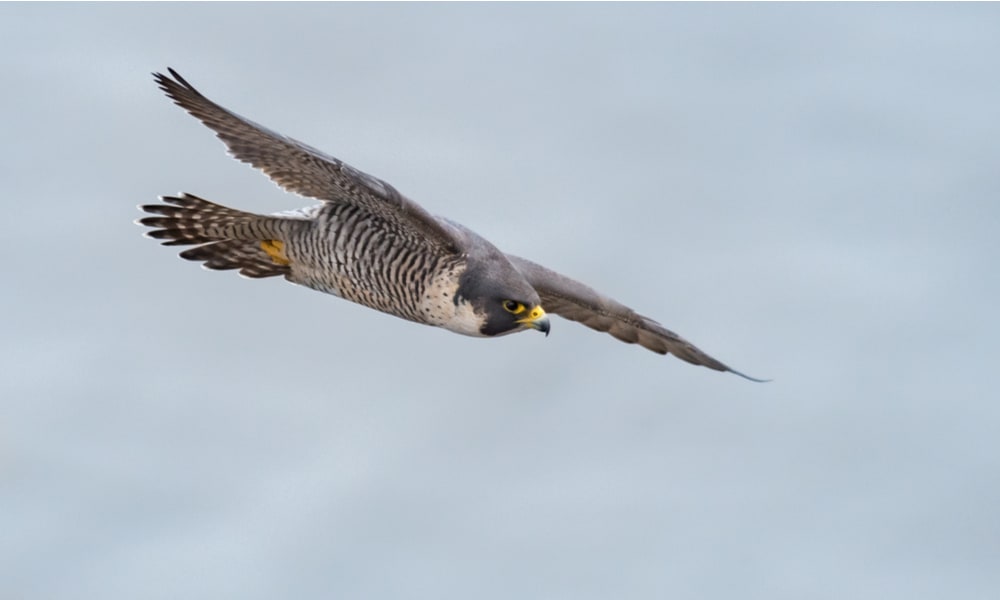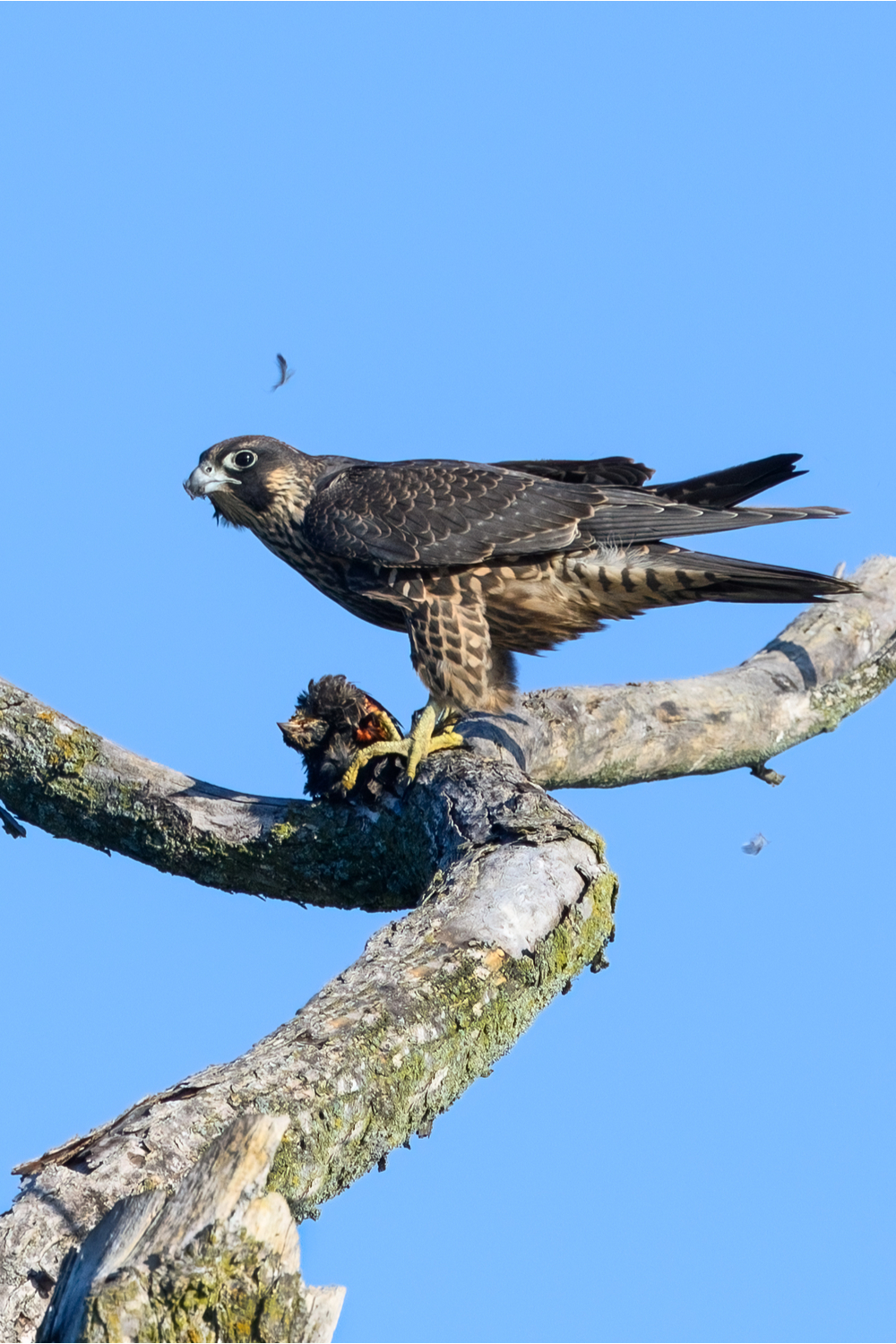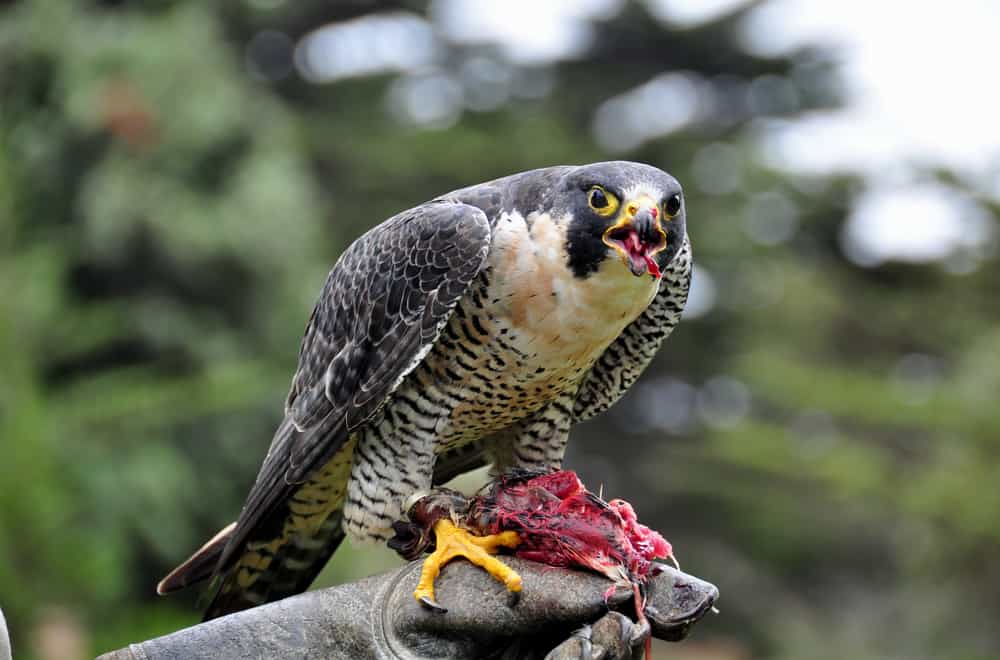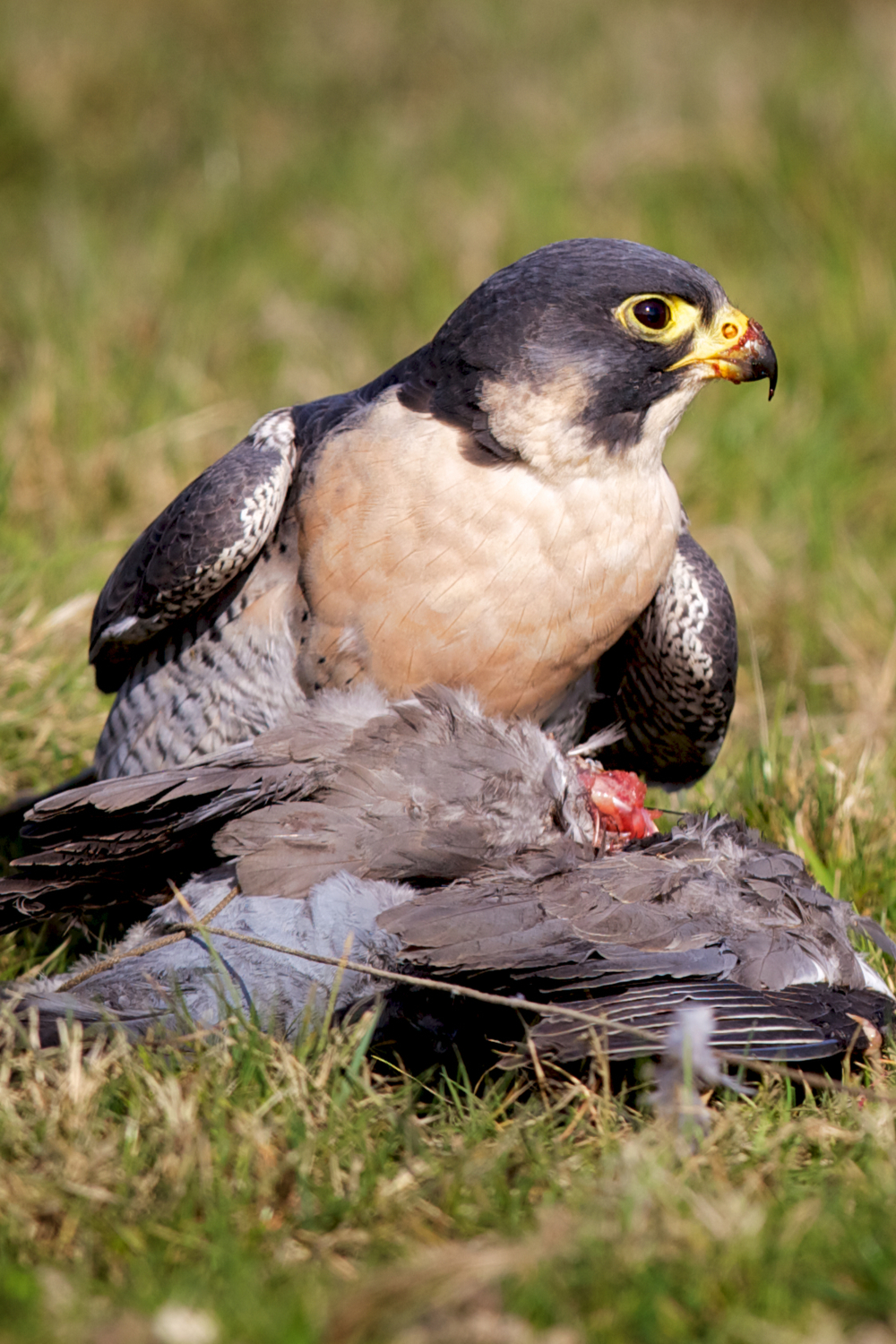Peregrine falcons, or simply peregrine, are one of the most recognizable hawk species. The bird has the size of a crow, and you can easily distinguish it by its beautiful gray and blue back. During its characteristic dive, the animal can reach a speed of 320 kilometers per hour.
In this article, we will talk about what do peregrine falcons eat and mention other fun facts.
Peregrine Falcons Habits and biology
An average falcon is somewhere between 34 to 58 centimeters long. Its wingspan can be anywhere from 74 centimeters to 120. For the most part, females and males are very similar, at least when it comes to feather color. But, the main difference between the sexes is that females are on average 30% larger. Males usually weigh around 650 grams, while females are 1,000 grams.
The bird has beautiful pointed wings and back that are black-blue with subtle gray undertones. Its top of the head, as well as the cheeks, are black. This creates a nice contrast to the bird’s white neck. Keep in mind that smaller birds are brown, for the most part. You can also recognize them as they have streaked instead of barred underpants.
According to the 1994 Handbook of the Birds of the World, there are 19 subspecies of the peregrine falcons. Although there are lots of these animals in the wild, they usually stick to specific regions. For example, they are very common in Europe and Australia, but you can only find a handful in the Americas.
Here are some of their most common habits:
- The species usually lives in the mountains, alongside rivers and coasts. However, there have been more and more peregrine falcons in urban areas in the last few years.
- These birds rarely migrate. Only species that live in very cold regions will fly to warmer areas.
- When diving, the bird needs to crash into its prey to slow itself down. According to experts, peregrine falcons can breathe in such a manner so that it doesn’t damage its lungs due to air pressure.
- Unfortunately, the bird’s speed is one of its biggest enemies. As a result, they often crash into Human-placed objects. Besides that, the species is regularly hunted by owls and other hawks.
What do peregrine falcons eat in the wild?
This species mostly focuses on eating other birds. Basically, they will attack anything smaller than them. If we’re talking about the North American falcons alone, they eat more than 450 different bird species. Given that peregrine falcons live on every continent, it isn’t surprising that they hunt more than 2,000 different animals across the globe.
Their pray can vary in size. For example, they can hunt something as little as a hummingbird, but they will also attack sandhill cranes. Usually, they hunt ducks, songbirds, gulls, and pigeons, but they can even eat fish, rodents, and bats on rare occasions.
According to research data, other birds make for 77% to 99% of the peregrine falcon’s diet. They usually sit on top of a high position scouting their prey. As soon as they notice a potential kill, they will dive straight towards it. Sometimes, peregrine falcons will hover when hunting, but this is very rare.
The bird’s talons are crucial for capturing the prey. However, they don’t kill with talons. The animal focuses on the prey’s backbone, completely crushing it with its beak. Then, the peregrine falcon will carry the carcass to the nearest tree or another vantage point and eat it there. Occasionally, the bird will store the prey for later use. When it catches a smaller animal, it isn’t unusual to eat it mid-flight.
Here are the things that peregrine falcon likes to eat the most:
- Pigeons
- Shorebirds
- Mourning doves
- Grouses
- Ptarmigans
- Waterfowl
- Songbirds
- Reptiles
- Mammals
- Fish
- Insects
- Amphibians
This species eats only meat. According to biologists, the average peregrine falcon requires about 70 grams of food each day. In terms of nutrients, they need about 15 grams of protein every day, about 4 to 5 grams of fats, 12 grams of calcium, and a little bit of phosphorous.
15 Facts about peregrine falcons
There are so many interesting things about this bird. It is a very recognizable species that evolution bestowed various qualities too. Here are some fun facts about peregrine falcon:
- Peregrine falcon is the fastest animal in the world, reaching the speed of 320 kilometers per hour when diving.
- Humans love these animals. They are easy to train, groom, and you can often find them in captive breeding. In fact, they’ve been bred for more than 3,000 years. We admire them for their speed and hunting skills, and peregrine falcons have incredible significance for many cultures.
- Like most other birds, when a peregrine falcon finds a mate, it sticks to it for the rest of its life. Otherwise, this is quite a solitary species.
- Every year, the couple will go back to their original nesting spot. They are very territorial birds, and pairs are usually one kilometer close to each other. The falcons nest on cliff edges. The female will choose the spot and will create a hollow in the soil. Unlike many other species, they don’t use the material for the nest.
- The animal lives from 19 to 25 years but can live much longer in captivity.
- There are so many peregrine falcons in the world, making them the most widespread raptor. Their population is rather healthy (categorized as least concerned), and they are not jeopardized in any way. Furthermore, there are between 100,000 to 500,000 of these animals in the wild.
- In the United Arab Emirates, the peregrine falcon is considered a national symbol. The same is true for the state of Idaho, where your can see the peregrine falcon on their commemorative quarter made in 2004. In many parts of the world, people see it as a bird of royalty.
- Over the millennia, the bird has evolved nictating membranes to protect its eyes from high speed. This membrane is translucent and can move horizontally. The bird also has a ridge that protects them from strong sunlight.
- In some parts of the world, airport employees use this bird as a sentry. They would release peregrine falcon near the airport so that it starts hunting and scaring away nearby birds. By doing so, it reduces the risk of bird collisions, increasing airplane security. During World War Two, the bird was used to intercept carrier pigeons.
- Some people accuse peregrine falcons of killing small farm animals like chickens. However, their economic impact is much less noticeable than the impact some other birds make. Furthermore, people often use the animal for pest control. Some farmers keep it so that the falcon can kill insects and rodents threatening the crops.
- According to experts, these birds have eyesight eight times better than humans. The eyes are crucial for hunting, allowing them to spot prey from up to 2 kilometers away. They work similarly to binoculars, allowing the species to focus on one particular spot in the distance and enlarge it. The precision at which they swoop in is remarkable, and it can compare only to several other bird species.
- On top of that, each eye works separately as it can track a different object. If that wasn’t enough, the bird could turn its head from side to side, giving it 360 degrees of vision.
- Genetically, these birds are much closer to parrots than other hawks. In 2012, their biological order was moved so that it’s closer to these birds. Among others, both parrots and peregrine hawks have a similar shape of teeth on beaks. That is something that eagles and hawks lack.
- The animal becomes sexually mature between ages one and three. If a bird lives within a larger population, it will become active at two to three years. During the mating, a male will try to attract a female by performing various aerial acrobatics. Among others, it will make steep dives and spirals. Another interesting thing that males do is feeding females while flying. To accomplish this, the female will have to fly upside down so that the male feeds her from above.
- On several occasions, the bird was close to extinction. The last time this happened was during the 1950s, 60s, and 70s when farmers started using various organochlorine pesticides. When eating animals and insects near farms, they would also consume this substance. It would build up in the animal’s tissue, reducing the calcium in their eggshells, effectively leading to population decline. This even led to the extinction of the species within certain regions. Luckily, as soon as the pesticide was banned, the population numbers bounced back.
Summary
Peregrine falcons are renowned for their speed. When diving, they are simply spectacular. The animal has several traits allowing them to be great hunters. Among others, this is why falconers simply love the species.
When courting, they use these skills to full display. Couples live together for the rest of their lives, and they return to their nest each year.
The animal focuses on other, smaller birds, but it can also eat insects and rodents in terms of the diet.



